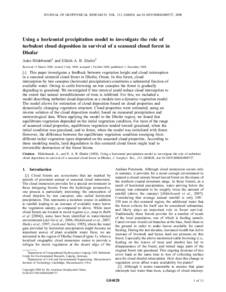Document
Total cloud cover climatology over the United Arab Emirates.
Identifier
DOI: 10.1002/asl.883
Source
Atmospheric Science Letters. v. 20, 2, e883
Contributors
Country
United Kingdom.
Publisher
John Wiley and Sons Ltd.
Gregorian
2019-02-01
Language
English
Subject
English abstract
Cloud climatologies are of great importance in the study of cloud dynamics and interactions with land, oceans and atmosphere. This study analyzes the climatology of Total Cloud Cover (TCC) over the United Arab Emirates (UAE). Monthly mean TCC data between 1984 and 2009 from ground observations at six UAE airport stations and the satellite-based (CLARA A2) product are utilized. The hourly ground observations are first filtered to match the overpass times of CLARA-A2 satellites over the UAE. Comparison between the datasets reveals higher TCC reports by CLARA-A2. These are attributed to several factors, such as the underestimation of TCC by human observers and the region's aerosol loading, surface albedo and emissivity, which impact the quality of remote sensing retrievals. Satellites utilized for CLARA-A2 are known to have undergone changes in their numbers and orbits over the years, prompting an investigation of its homogeneity. Change points are found to occur in 1991 and 1998, related to increased satellite measurements and sensor changes, respectively. Further investigations of the homogeneity of means and variances before and after the change points are also conducted, resulting in confirmation of the inhomogeneity induced by artifacts. Monthly means of hourly ground observations are then used for analysis of TCC climatology over the six stations. Fujairah has the highest TCC on average, due to its proximity to the Hajar mountains and the Oman gulf. Most of the stations exhibit significant decreasing trends, in addition to a change point occurring in 1998. This is theorized to be related to the El Niño Southern Oscillation phase change occurring in the same period. The potential teleconnection is explored further through testing for correlations of TCC with the Oceanic Niño Index, with results showing a strong link in the fall–winter seasons.
ISSN
1530-261X
Category
Journal articles




